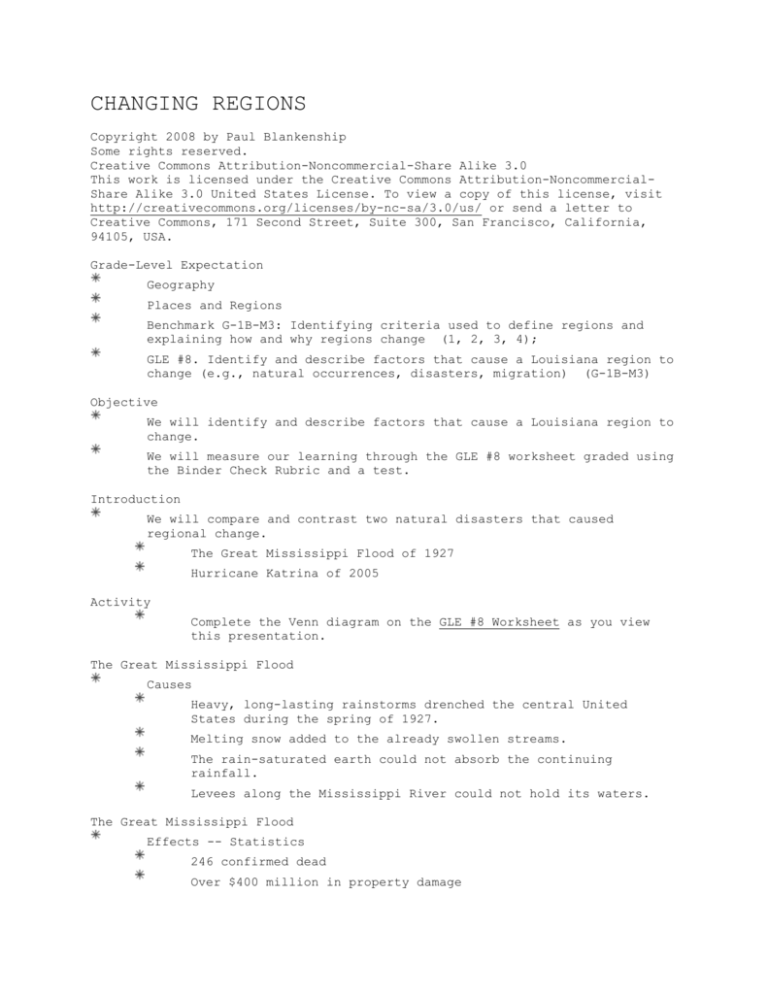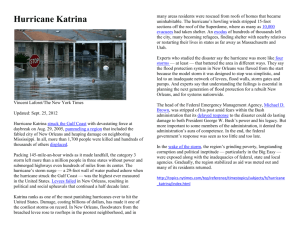
CHANGING REGIONS
Copyright 2008 by Paul Blankenship
Some rights reserved.
Creative Commons Attribution-Noncommercial-Share Alike 3.0
This work is licensed under the Creative Commons Attribution-NoncommercialShare Alike 3.0 United States License. To view a copy of this license, visit
http://creativecommons.org/licenses/by-nc-sa/3.0/us/ or send a letter to
Creative Commons, 171 Second Street, Suite 300, San Francisco, California,
94105, USA.
Grade-Level Expectation
Geography
Places and Regions
Benchmark G-1B-M3: Identifying criteria used to define regions and
explaining how and why regions change (1, 2, 3, 4);
GLE #8. Identify and describe factors that cause a Louisiana region to
change (e.g., natural occurrences, disasters, migration) (G-1B-M3)
Objective
We will identify and describe factors that cause a Louisiana region to
change.
We will measure our learning through the GLE #8 worksheet graded using
the Binder Check Rubric and a test.
Introduction
We will compare and contrast two natural disasters that caused
regional change.
The Great Mississippi Flood of 1927
Hurricane Katrina of 2005
Activity
Complete the Venn diagram on the GLE #8 Worksheet as you view
this presentation.
The Great Mississippi Flood
Causes
Heavy, long-lasting rainstorms drenched the central United
States during the spring of 1927.
Melting snow added to the already swollen streams.
The rain-saturated earth could not absorb the continuing
rainfall.
Levees along the Mississippi River could not hold its waters.
The Great Mississippi Flood
Effects -- Statistics
246 confirmed dead
Over $400 million in property damage
Around 27,000 square miles of land flooded
The Red Cross assisted over 640,000 survivors of the Great
Mississippi Flood.
Over 307,000 lived in 154 Red Cross camps.
The Great Mississippi Flood
Effects -- Civil Liberties Lost
African-Americans were forced at gunpoint to stay in
flooded areas and work to reinforce the levees.
The National Guard was used to confine African-Americans
in relief camps.
The Great Mississippi Flood
Effects -- The Poor Leave or Rise Against the Elite
Many African-Americans left their lives as sharecroppers and
moved to industrial centers such as Detroit and Chicago where
they increased their incomes by finding work in factories.
Rural whites, outraged by the destruction of the levee at
Caernarvon and the intentional flooding of St. Bernard Parish to
protect New Orleans, voted out the New Orleans political machine
and elected Huey P. Long.
The Great Mississippi Flood
Effects -- National Politics
Secretary of Commerce Herbert Hoover, appointed by President
Calvin Coolidge as the head of disaster relief, was widely
applauded for his work.
He had directed food relief efforts to bring U. S. aid to
Belgium in World War I.
In 1928 he was elected President by a grateful nation.
Hurricane Katrina
Causes of Hurricanes
Hurricanes are caused as warm, moist air near the ocean surface
rapidly rises. The moisture condenses and releases heat, warming
the air at higher altitudes.
A cycle is created that draws more air from the surface.
Converging winds near the equator collide and accelerate the
rising air.
The spinning storm system that results may become a hurricane.
Hurricane Katrina
Causes of the Flooding in New Orleans
The wind from Hurricane Katrina that hit New Orleans caused some
damage, but flooding was the main problem for the city.
The damage caused by Hurricane Katrina was largely the result of
the failure of levees that allowed the city to flood.
A lawsuit by an environmentalist group in 1977 prevented
the U. S. Army Corps of Engineers, the agency responsible
for the levees, from building a better levee system
(source).
Hurricane Katrina
Causes of Government Failures During and After the Storm
Federal Level of Government
President George W. Bush appointed Michael Brown, the former
head of the American Quarter Horse Association, as the head of
the Federal Emergency Management Agency despite his lack of
credentials or experience in disaster management.
Like some other Bush appointees, his appointment seems to
have been a matter of political connections rather than
expertise.
Hurricane Katrina
Causes of Government Failures During and After the Storm
State Level of Government
Governor Kathleen Blanco was blamed for a slow response to
the storm.
The Bush Administration accused Governor Blanco of
refusing to cooperate with Federal efforts and
declining to permit the Federalization of the
Louisiana National Guard.
The Road Home Program, established by the Blanco
Administration, failed to provide promised financial
aid to help storm victims rebuild in a timely
manner.
Hurricane Katrina
Causes of Government Failures During and After the Storm
Local Level of Government
New Orleans Mayor Ray Nagin was faulted for neglecting to
use school buses to evacuate residents before the storm.
Some New Orleans police officers fled rather than face the
storm. Others were accused of theft in the days following
the storm.
Hurricane Katrina
Effects -- Statistics
Over 1,800 dead
In excess of 250,000 homes and businesses destroyed
About 200 square miles of wetlands damaged or destroyed
More than $80 billion in damages
Hurricane Katrina
Effects -- Civil Liberties
Citizens lawfully in possession of firearms were forcibly
disarmed by the government in violation of the Second Amendment.
The City of New Orleans was forced to return confiscated
firearms. Mayor Nagin was found in contempt by the federal judge
hearing the case for failing to turn over documents related to a
lawsuit by the National Rifle Association.
Hurricane Katrina
Effects -- Population Loss
Population reduced for New Orleans through evacuation and
relocation, possibly resulting in a loss of congressional
representation for Louisiana in the 2010 Census and subsequent
reapportionment.
Many people living in poverty could not afford to evacuate
before the storm. After they were relocated by the
government they could not afford to return to New Orleans.
Hurricane Katrina
Effects -- Political
President George W. Bush’s administration was widely criticized
for failures at the federal level of government.
Louisiana Governor Kathleen Blanco, blamed for state government
failures, did not run for reelection.
New Orleans Mayor Ray Nagin was reelected.
Conclusion
Both the Great Mississippi Flood of 1927 and Hurricane Katrina caused
death and destruction.
The poor were most affected by each disaster as they had fewer
resources to use to evacuate or relocate.
Each disaster had political consequences for elected officials
perceived to have failed in their duties.
Discussion Questions
How did regions of Louisiana change after the Great Mississippi Flood
of 1927?
How did regions of Louisiana change after Hurricane Katrina?
What changes were different in the two disasters?
What changes were similar in the two disasters?
Sources
Barry, John M. Rising Tide: The Great Mississippi Flood of 1927 and
How it Changed America. New York: Touchstone, 1997.
Wall, Bennett, et. al. Louisiana: A History. 5th ed. Wheeling, IL:
Harlan Davidson, 2008.
Online resources related to GLE #8 may be found at:
http://delicious.com/LouisianaStudies/gle08








